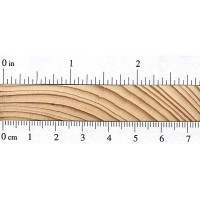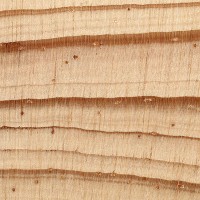 |
Common Name(s): Spruce Pine
Scientific Name: Pinus glabra Distribution: Southeastern United States (coastal plain) Tree Size: 65-100 ft (20-30 m) tall, 2-3 ft (.6-1 m) trunk diameter Average Dried Weight: 33 lbs/ft3 (525 kg/m3) Specific Gravity (Basic, 12% MC): .42, .52 Janka Hardness: 700 lbf (3,110 N) Modulus of Rupture: 10,300 lbf/in2 (71.0 MPa) Elastic Modulus: 1,405,000 lbf/in2 (9.69 GPa) Crushing Strength: 5,660 lbf/in2 (39.0 MPa) Shrinkage: No data available |
Color/Appearance: Heartwood is reddish brown, sapwood is yellowish white.
Grain/Texture: Straight grained with a fine to medium texture.
Endgrain: Large resin canals, numerous and evenly distributed, mostly solitary; earlywood to latewood transition abrupt, color contrast relatively high; tracheid diameter medium-large.
Rot Resistance: The heartwood is rated as moderate to low in decay resistance.
Workability: Overall, Spruce Pine works fairly well with most tools, though the resin can gum up tools and clog sandpaper. Spruce Pine glues and finishes well.
Odor: Has a distinct smell that is shared among most species in the Pinus genus.
Allergies/Toxicity: Working with pine has been reported to cause allergic skin reactions and/or asthma-like symptoms in some people. See the articles Wood Allergies and Toxicity and Wood Dust Safety for more information.
Pricing/Availability: Spruce Pine has a lower density than most other species in the Southern Yellow Pine grouping, hence its distribution is more generally restricted to local lumber needs and plywood production. The wood is sometimes sold as Southern Yellow Pine for a moderate price.
Sustainability: This wood species is not listed in the CITES Appendices, and is reported by the IUCN as being a species of least concern.
Common Uses: Southern Yellow Pine is used for heavy construction, such as: bridges, beams, poles, railroad ties, etc. It’s also used for making plywood, wood pulp, and veneers.
Comments: Spruce Pine is one of the least common species of pine found in the southeastern United States, and is usually only found in scattered groups or as isolated trees within a mixed forest.
- Austrian Pine (Pinus nigra)
- Caribbean Pine (Pinus caribaea)
- Eastern White Pine (Pinus strobus)
- Jack Pine (Pinus banksiana)
- Jeffrey Pine (Pinus jeffreyi)
- Khasi Pine (Pinus kesiya)
- Limber Pine (Pinus flexilis)
- Loblolly Pine (Pinus taeda)
- Lodgepole Pine (Pinus contorta)
- Longleaf Pine (Pinus palustris)
- Maritime Pine (Pinus pinaster)
- Ocote Pine (Pinus oocarpa)
- Patula Pine (Pinus patula)
- Pinyon Pine (Pinus edulis)
- Pitch Pine (Pinus rigida)
- Pond Pine (Pinus serotina)
- Ponderosa Pine (Pinus ponderosa)
- Radiata Pine (Pinus radiata)
- Red Pine (Pinus resinosa)
- Sand Pine (Pinus clausa)
- Scots Pine (Pinus sylvestris)
- Shortleaf Pine (Pinus echinata)
- Slash Pine (Pinus elliottii)
- Sugar Pine (Pinus lambertiana)
- Sumatran Pine (Pinus merkusii)
- Table Mountain Pine (Pinus pungens)
- Western White Pine (Pinus monticola)
- Virginia Pine (Pinus virginiana)
Scans/Pictures: There are currently no pictures of this exact wood species, but a similar species within the Pinus genus is being substituted (P. clausa). If you’d like to contribute a wood sample of this specific species to be scanned, (even small pieces of veneer can be sent), please use the contact form.
 |
 |
 |
 |





Is spruce is better to use for construction or pine
It depends. Need more info on application.
Thanks for sharing useful stuff as well as informative but i want to know more on Pine burada?
The Article is good and very much helpful for us .And u can specify the related Articles also that would be beneficial for us .Thankyou for sharing with us.